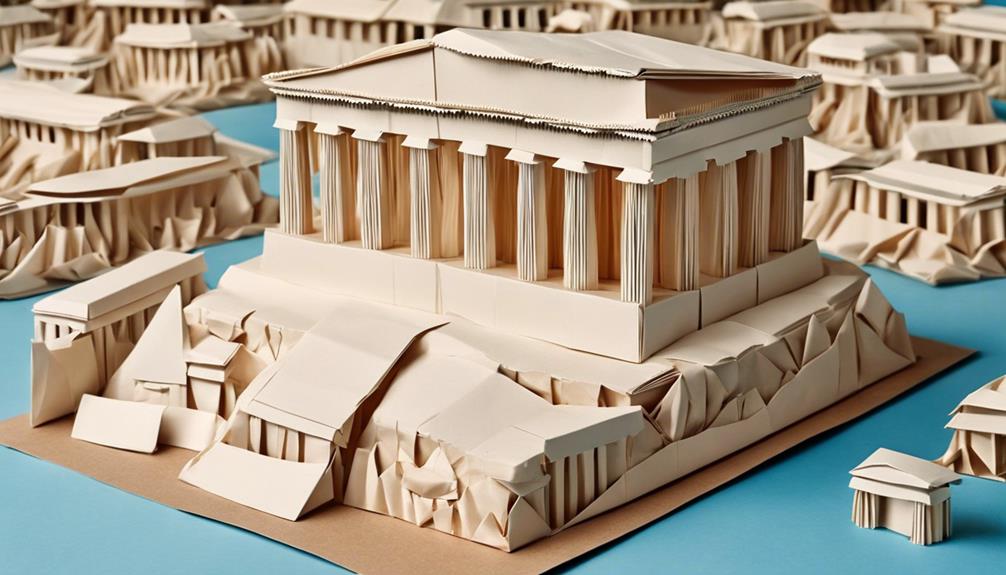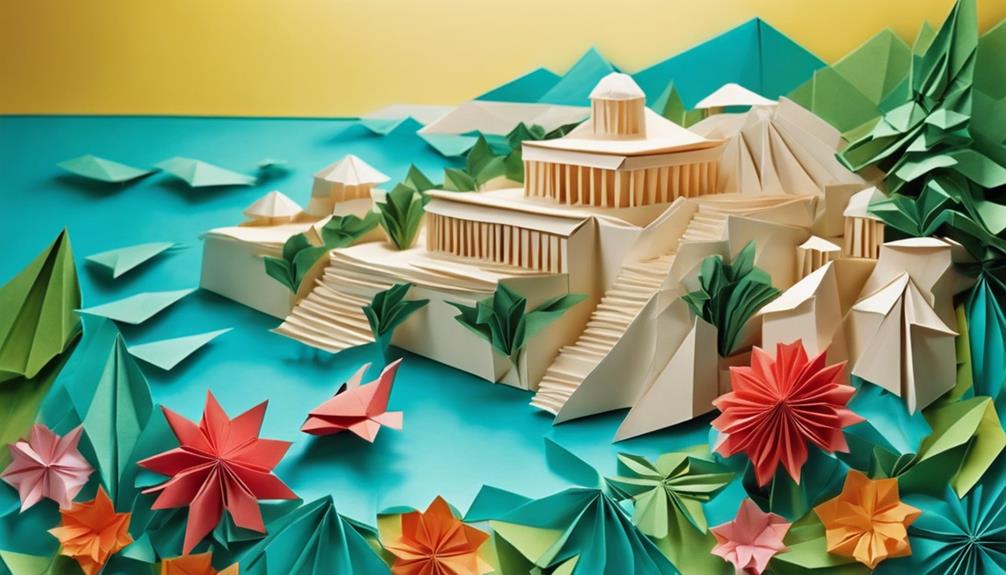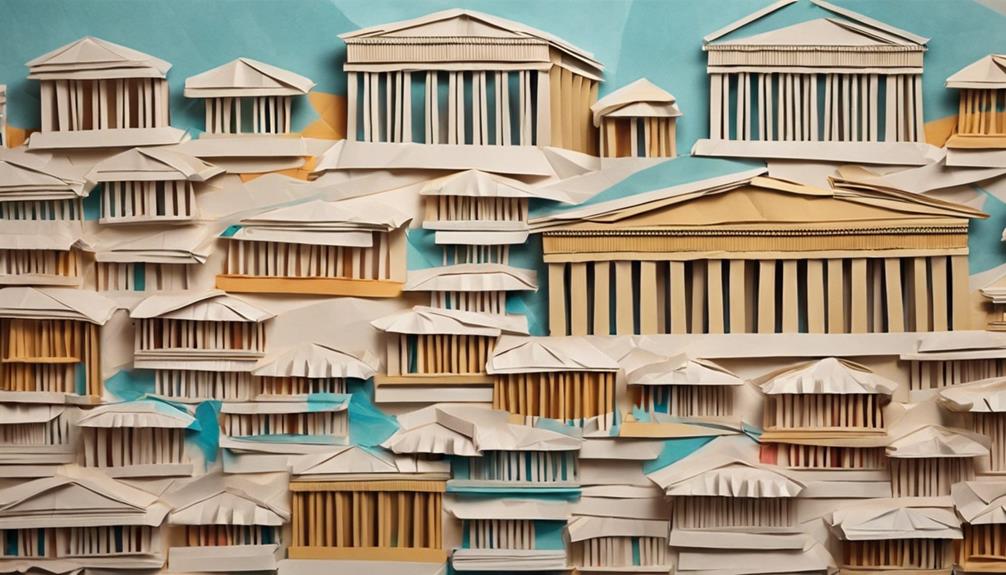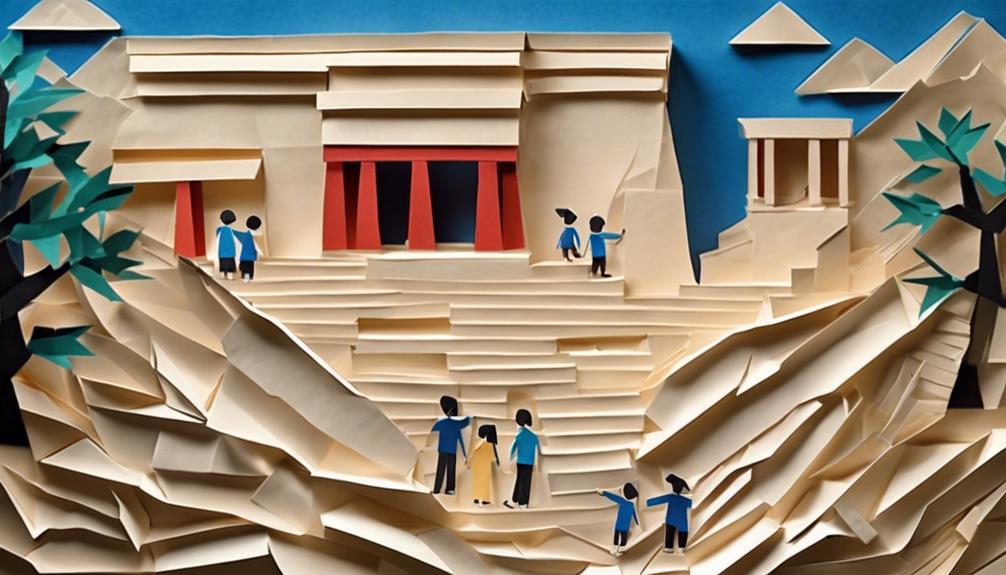Ancient Athens, the cradle of democracy and Western civilization, showcases iconic ruins like the majestic Acropolis and the grand Parthenon, embodying the city's rich history and vibrant essence. These architectural marvels, adorned with Doric columns and intricate sculptures, symbolize power and Greek engineering finesse. The Temple of Hephaestus, dedicated to the deity of craftsmanship, boasts magnificent marble carvings and Doric columns, reflecting ancient artistry. The Roman Agora, a blend of Roman and Greek styles, offers a glimpse into Athens' bustling commercial past. Athens' evolution through different eras and its modern blend of ancient charm with contemporary vibrancy further enhance its allure.
Key Takeaways
- Iconic ruins like the Acropolis and Parthenon symbolize Ancient Athens's power and architectural prowess.
- The Ancient Agora served as a bustling hub for activities and democratic processes.
- Roman Agora remnants blend Roman and Greek styles, offering insights into ancient commerce.
- Neoclassical Athens showcases a fusion of ancient and modern architectural styles.
- Modern Athens combines ancient charm with contemporary vibrancy, reflecting a rich cultural tapestry.
Ancient Athens: A Historical Overview
Athens, known as the birthplace of democracy and Western civilization, boasts iconic ruins such as the Acropolis and Parthenon. The Acropolis, a monumental citadel perched above the city, houses various ancient structures like the Parthenon, the Temple of Athena Nike, and the Erechtheion. Among these, the Parthenon stands out as a symbol of classical architecture and power.
The Ancient Agora, located northwest of the Acropolis, served as a hub for commercial, social, and political activities in ancient Athens. This historical marketplace and civic center played an essential role in the development of democracy and Western civilization. The Agora was a bustling area where Athenians gathered for trade, discussions, and political debates, shaping the fabric of society.
The architectural features of these iconic ruins in Athens reflect the mastery of ancient Greek engineering skills, with intricate marble carvings and a blend of Doric and Ionic styles that continue to captivate visitors from around the world.
The Parthenon: Symbol of Power
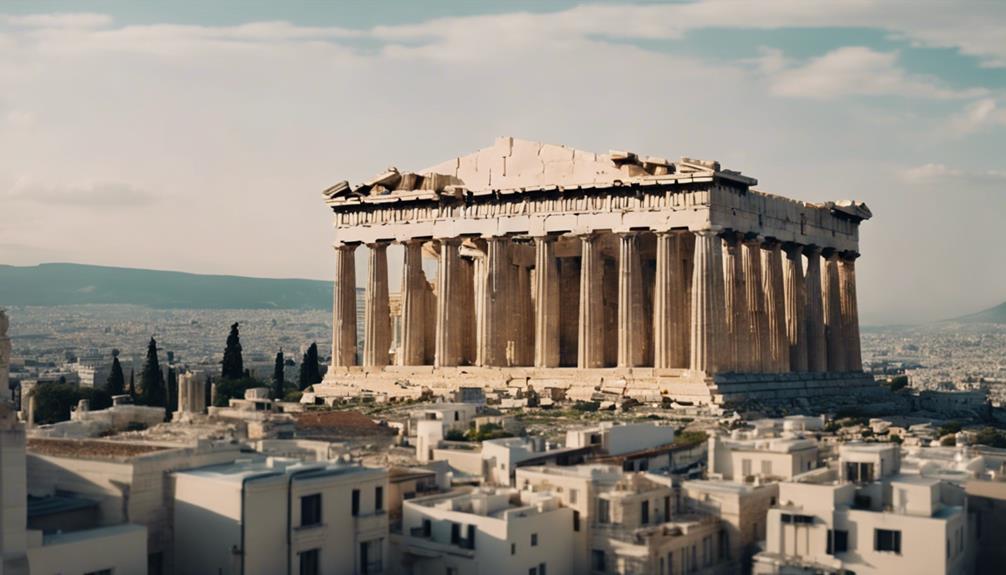
Standing proudly atop the Acropolis, the Parthenon serves as an enduring symbol of power and influence in ancient Greek history. The Parthenon, dedicated to Athena, commenced construction in 447 BC, representing the pinnacle of Ancient Greece's glory. This iconic structure showcases Doric columns and intricate sculptures, embodying harmony and highlighting Greek artistry. Despite enduring damage during wars, the Parthenon has stood the test of time and was designated a UNESCO World Heritage Site in 1987, symbolizing democracy and Western civilization. As one of the most visited landmarks in ancient Athens, the Parthenon attracts millions of tourists annually, drawn to its historical significance and architectural grandeur. Its timeless presence serves as a testament to the power and legacy of ancient civilization in Athens.
| Key Points | Details | Importance |
|---|---|---|
| Construction Year | Began in 447 BC | Represents Ancient Greece's peak |
| Architectural Features | Doric columns, intricate sculptures | Embody harmony and artistry |
| UNESCO Designation | Received in 1987 | Symbolizes democracy |
| Tourist Attraction | Millions visit annually | Highlights historical significance |
| Symbol of Power | Enduring legacy in Greek history | Represents ancient civilization |
Temple of Hephaestus: Architectural Marvel
The Temple of Hephaestus, boasting remarkable preservation, stands as a proof of ancient Greek architectural prowess. Situated in the Ancient Agora of Athens, this temple is dedicated to the god Hephaestus, the patron of metalworking and craftsmanship. Its Doric columns and intricate marble carvings exemplify the mastery of ancient Greek architecture and artistry.
Visitors can immerse themselves in the serene ambiance surrounding the temple, offering a glimpse into the rich cultural heritage of ancient Athens. For a ticket cost ranging from €5-10, individuals can explore the structural grandeur and historical significance of this architectural marvel.
As a symbol of continuity and Western civilization, the Temple of Hephaestus serves as a demonstration to the enduring legacy of ancient Greek civilization. Its presence in the Ancient Agora not only highlights its religious importance but also underscores its role as a center for civic gatherings and activities.
This well-preserved temple stands as a beacon of the past, inviting visitors to unravel the secrets of ancient Greek architectural ingenuity.
Roman Agora: Marketplace Remnants

How did the Roman Agora in Athens become an essential center for ancient commerce and social interactions?
The Roman Agora played a vital role in the commercial activities and social life of ancient Athens. This marketplace, blending Roman and Greek architectural styles, stood as a demonstration of the city's bustling trade and vibrant community interactions.
Visitors today can witness this historical site's remnants, offering a glimpse into the past glory of Athens. The Roman Agora welcomes guests daily from 8 AM to 3 PM, allowing them to explore the ancient marketplace and appreciate its significance within the city's history.
Tickets for entry typically range from €4 to €8, granting access to a rich archaeological site that sheds light on the commercial and social dynamics of ancient Athenians.
Situated near Plaka, the Roman Agora remains an engaging destination, inviting visitors to immerse themselves in the intriguing world of ancient commerce and social gatherings in Athens.
Athens in the 19th Century
In the 19th century, Athens underwent a significant transformation that saw the emergence of a cultural renaissance and accelerated urban development. This period marked a pivotal moment in the city's history, shaping its modern identity and laying the foundation for the vibrant metropolis it's today.
The 19th-century Athens not only witnessed architectural advancements and infrastructural growth but also experienced a resurgence of artistic and intellectual pursuits that enriched the fabric of the city.
19th Century Transformation
During the 19th century, Athens underwent significant transformations, setting the stage for its eventual hosting of the 2004 Olympic Games. The cityscape beneath Lycabettus Hill provided a glimpse into Athenians' daily lives in the 19th century, with bustling markets and narrow streets defining the urban landscape.
Neoclassical buildings dotted the city, showcasing a profound reverence for Athens's ancient past, blending the old with the new in architectural splendor. Notably, the absence of high-rise structures in 19th-century Athens hinted at a more intimate and interconnected urban environment, where residents lived in closer proximity to one another.
Despite these changes, Athens remained a living city, serving as a custodian of an extraordinary cultural and historical legacy. These 19th-century transformations laid the groundwork for Athens to evolve into the vibrant metropolis that would captivate the world during the 2004 Olympics, harmonizing its rich history with modernity in a way that continues to attract visitors from across the globe.
Cultural Renaissance Emerges
Emerging in the 19th century, Athens experienced a profound cultural renaissance that celebrated its ancient heritage while embracing modern influences. This revival saw the city evolve into a vibrant hub of artistic and intellectual activity, where the echoes of antiquity harmonized with contemporary creativity.
The Acropolis Museum: Established in 2009, this modern architectural marvel houses an extensive collection of artifacts from the Acropolis, offering visitors a deeper understanding of Athens's rich history.
The Stoa of Attalos: A stunning reconstruction of the ancient stoa located in the Agora of Athens, this site became a focal point for cultural events and exhibitions, bridging the gap between the past and the present.
Cultural Festivals: Athens became a breeding ground for cultural festivals, showcasing music, theater, and art, attracting talents from across the globe.
Literary Salons: Intellectual salons sprung up around the city, where writers, philosophers, and artists engaged in lively discussions, fueling the intellectual pulse of Athens.
Urban Development Accelerates
Athens in the 19th century witnessed a rapid acceleration in urban development and transformation. As the city embraced its ancient Greek roots, neoclassical buildings began to emerge, adding a new dimension to the cityscape nestled beneath the watchful gaze of Lycabettus Hill. Unlike modern cities with towering skyscrapers, Athens of this era maintained a more intimate and historically significant layout, evident in the absence of high-rise structures.
Through the lens of photographers like Jakob August Lorent, the evolving urban fabric captured Athenians' daily lives, showcasing the shift from ancient ruins to a bustling modern metropolis. This period marked a pivotal moment in Athens's history, where the cityscape evolved to reflect both its rich cultural heritage and its aspirations for a vibrant future.
The careful balance between preserving the ancient Greek legacy and embracing urban development set the stage for Athens to become a timeless symbol of historical significance intertwined with contemporary progress.
Neoclassical Athens: Architectural Splendor
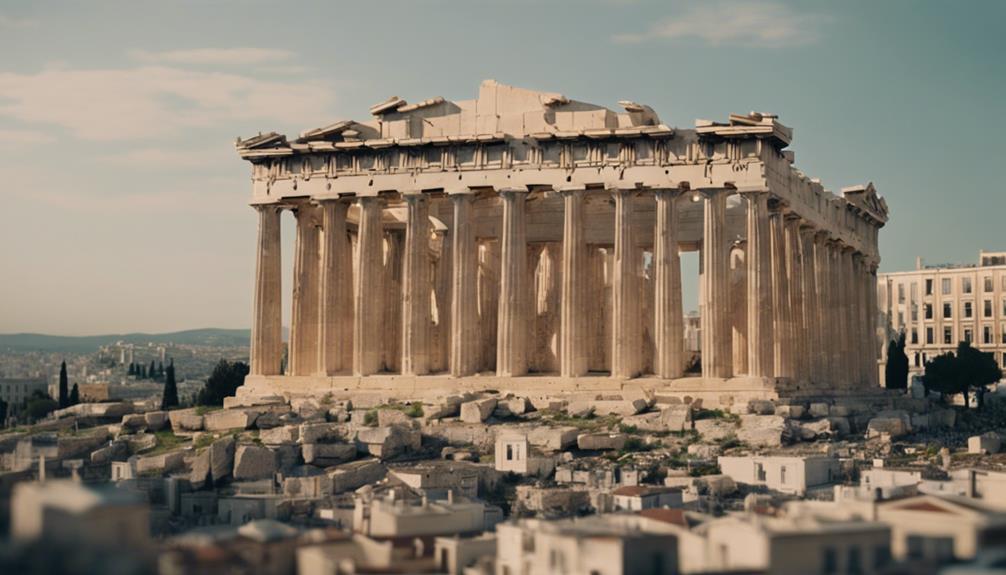
The fusion of ancient and modern architectural styles in Neoclassical Athens creates a mesmerizing blend that pays homage to Greece's rich historical legacy.
Neoclassical Athens showcases a unique architectural splendor that seamlessly integrates elements from ancient wonders like the Parthenon, dating back to the 5th century BCE, with modern design concepts.
The city's neoclassical buildings stand as elegant commemorations to the grandeur of Greece's past, reflecting a deep reverence for its historical significance.
Walking through the streets of Athens, one can witness a shift through time, where neoclassical structures coexist harmoniously with remnants of antiquity.
The absence of high-rise buildings in Athens contributes to the city's intimate charm, allowing visitors to immerse themselves in a historical ambiance.
These neoclassical gems not only showcase Athens' architectural evolution but also serve as affirmations to the city's commitment to preserving its rich heritage.
Daily Life in Ancient Athens

Neoclassical Athens's architectural splendor smoothly shifts into a vivid portrayal of daily life in ancient Athens, focused on bustling marketplaces and historic meeting places. The heart of Athens beat strongest at the Ancient Agora, a bustling marketplace where citizens congregated for trade and social interactions. This vibrant hub also served as the political and civic center of the city, adorned with council houses and the Panathenaic way traversing through its midst.
At the Pnyx, another essential site, citizens engaged in democratic processes, gathering for important assemblies and speeches that shaped the course of Athenian society.
The Stoa of Attalos, a reconstructed ancient stoa within the Agora, provided shelter and respite for Athenians conducting business or socializing, enhancing the daily interactions of the populace. Additionally, the Odeon of Herodes Atticus, an ancient amphitheater, enriched the cultural life of Athens, hosting performances during the renowned Athens Festival in honor of the city's patron goddess.
Athens Today: Modern Metropolis

Occasionally blending ancient charm with contemporary vibrancy, this modern metropolis of historical significance pulsates with diverse cultural influences. Athens today is a bustling city where the past meets the present, shaping the daily lives of its inhabitants and visitors alike. The enduring legacy of this ancient city can be felt in every corner, from its iconic landmarks to the rich cultural tapestry that adorns its streets.
Cultural Fusion: Athens, as the first European city from the Middle East, reflects a unique blend of cultures, creating a vibrant and diverse atmosphere.
Modern Amenities: Despite its ancient roots, Athens boasts modern amenities, offering residents and tourists a comfortable and convenient urban experience.
Artistic Hub: The city hosts a plethora of cultural events, festivals, and theatrical performances throughout the year, showcasing its artistic prowess and attracting global audiences.
Historical Treasures: The National Archaeological Museum in Athens preserves a vast collection of artifacts, providing a window into the city's ancient past and enriching its contemporary identity.
Frequently Asked Questions
What Is the Famous Ruin in Athens?
The famous ruin in Athens is the Parthenon, a majestic temple on the Acropolis dedicated to Athena.
Construction began in 447 BC, showcasing intricate sculptures symbolizing Ancient Greece's grandeur. A UNESCO World Heritage Site since 1987, the Parthenon embodies democracy and Western civilization.
Millions of tourists visit annually, drawn by its Doric columns and historical significance. It stands as a tribute to Ancient Greece's architectural and cultural prowess.
What Was Ancient Athens Known For?
Ancient Athens was known for its pivotal role in the development of democracy and Western civilization. The city's rich cultural heritage spans thousands of years, showcasing intellectual and artistic achievements.
This historical hub birthed renowned philosophers, such as Socrates and Plato. Its iconic ruins like the Acropolis and Parthenon attract millions of tourists annually, offering insights into ancient Greek culture.
Athens's UNESCO World Heritage Sites and archaeological treasures highlight its profound historical significance.
What Is the Heart of Ancient Athens?
The heart of ancient Athens beats within its iconic ruins, each stone echoing the tales of a bygone era. From the towering Acropolis to the majestic Parthenon and the grand Temple of Olympian Zeus, these remnants stand as evidence to a rich cultural heritage dating back millennia.
This ancient city's core is a treasure trove of history and significance, offering a window into the grandeur and legacy of Athens through the ages.
What Is Unique About Athens?
Athens stands out for its rich historical significance, serving as the cradle of Western civilization. Its unique blend of Eastern and Western influences has shaped its architecture, culture, and political systems for millennia.
The city's symbolic importance as the first European city from the Middle East highlights its distinct identity. Athens's physical geography, with surrounding mountains and rivers, further adds to its exceptional character, making it a truly unparalleled destination for explorers of history and culture.
Conclusion
To sum up, Ancient Athens's iconic ruins and lively pulse continue to captivate visitors from around the world. As the saying goes, 'All roads lead to Rome,' but in Athens, all roads lead to a rich history and vibrant culture.
From the majestic Parthenon to the bustling Roman Agora, the city's ancient past is still palpable today. With its blend of ancient wonders and modern metropolis, Athens truly offers a unique experience for any history enthusiast or urban explorer.

